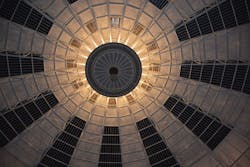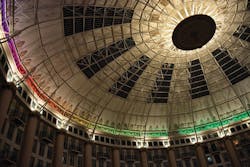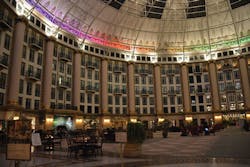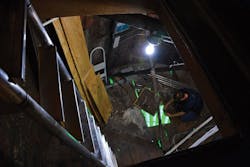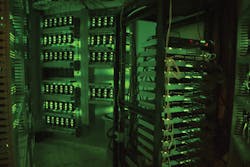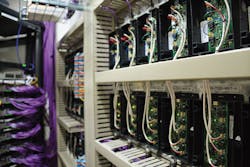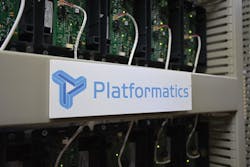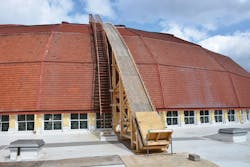Relighting West Baden Springs Hotel: Where modernization meets preservation
By Amir Sekhavat and James Neeley, Superior Essex and Matt Laherty, Platformatics
The West Baden Springs Hotel, located in French Lick, IN, is one of the United States’ premier luxury resorts and one of its most treasured landmarks. Its history stretches back more than a century and touches many of our national heroes and pastimes, from presidential politicians to world-champion baseball teams. The original draw was the resort’s mineral springs and baths—technological marvels of their time, notable for their salubrious effects. Today, the West Baden Springs Hotel maintains that rich legacy by offering its guests world-class hospitality in an historic setting, with a variety of modern amenities that make each guest experience uniquely enjoyable.
The hotel itself sits comfortably nestled in the southern Indiana countryside, where its magnificent dome royally emerges from the surrounding, thick forests like a crown. The first iteration of the dome was built in 1902 after a fire burned the original wooden structure to the ground. The owner at that time, Lee Wiley Sinclair, decided to rebuild the facility, which would include one of the greatest architectural marvels of the era. With the engineering expertise of architect Harrison Albright, Sinclair succeeded, and reopened the West Baden Springs Hotel in late 1902. Referred to by some as the Eighth Wonder of the World, its dome was the largest free-spanning dome in the world for more than 50 years, stretching 200 feet in diameter and 95 feet, 6 inches tall.
The dome is designed with 12 large windows separated by solid panels of steel and brick, and supported by a neat arrangement of whitewashed struts. At the apex of dome, hanging down like a stalactite, is a large, ornately designed pinwheel filled with lights. When illuminated, it casts a warm glow that emanates out toward the windows, and then cascades down the curved ceiling and the large columns until it is reflected off the mosaic terrazzo tile floor below. The effect is magical, and it is not lost on the guests, who travel from all around the globe to experience the hotel’s unique history, architecture, and services firsthand.
Retrofitting for the past and future
When the Cook Group took over the West Baden Springs Hotel in 1996, it sought to continue the resort’s long tradition of enhancing its guest experience with modern, innovative technologies. “I think being on the leading edge of technology is what guests expect of our resort, both historically and now,” says Brent Conner, director of architecture and engineering for Cook Group. “Our philosophy, in general, has been staying on the front edge of that technology. In the past, the spa and the steam baths were cutting edge in their day. Today, I think that still carries through. Today’s guests expect top quality. They expect a friendly atmosphere. Cook Group has tried to make sure that happens.”
Seeking to boost operational efficiencies and improve its guest experience, the Cook Group sought the expertise of Superior Essex and Platformatics in retrofitting the atrium with the latest intelligent LED lighting technologies. Together, they provided a connected lighting solution that offered West Baden Springs Hotel significant increases in energy efficiency and customizability, while also establishing a foundation for future converged network applications that will continue to add value as the hotel expands its in-building network. “Platformatics came to us and gave us a really great presentation of what abilities and capabilities are out there with regard to PoE lighting,” says Conner. “We felt like this was the perfect application for what we needed and what they were trying to do.”
Relighting the West Baden Springs atrium came with a number of criteria defined explicitly by the end-users’ needs. Because of the size of the space and the number of lights therein, energy efficiency was paramount. Previously, the hotel had used 192, 1000-watt bulbs to light the atrium, equating to approximately 190,000 watts of power when operating at full capacity. These incandescent bulbs also generated a significant amount of heat, and as a result there was a substantial heat load that had to be managed via ventilation and cooling, which added to overall energy requirements.
Additionally, the Cook Group wanted to maintain the distinct look and feel of the architecturally complex space, specifically the warmth that they had achieved with their incandescent lighting. There was also a desire for more discrete control of both the white and color lights such that they could be customized with more ease than the incandescent fixtures.
Finally, several unique challenges had to be overcome in terms of designing and deploying the physical infrastructure. The project required around 30,000 feet of Ethernet cable, hundreds of light fixtures and PoE nodes, and several cabinets filled with Power over Ethernet switches and network hardware. However, due to the historic nature of the building, it would not readily accommodate the robust network infrastructure required for this application. Adding to the complexity of the installation, none of the original lighting infrastructure was accessible without a lift. From a serviceability standpoint, this meant that the components could not be easily reached and replaced. Therefore, a completely new design was needed for the Platformatics lighting system—one that easily could be integrated and managed without interfering with the atrium’s architectural features or guest experience.
Beauty and efficiency converged
The solution devised by the Superior Essex and Platformatics teams was both innovative and effective. Using a centralized model, system designers built a micro data center or server room on top of the dome, where the cabinets, switches, area controllers and other network hardware would reside. This would keep a large portion of the physical infrastructure from interfering with the atrium’s architectural features, and out of the view of guests.
Even with a system designed to work with the building’s unique architectural characteristics, installers faced an additional hurdle just to get the materials in place because there was no readily accessible path to the top of the dome, and certainly not one by which loads of network hardware and other building materials could be transported. To overcome this challenge, the installation teams built a track that scaled the exterior of the dome, stretching from the flat roof, up the rounded surface to the compression ring at the top. Using a makeshift cart to travel the length of the track, they were able to get the materials in place to build the server room and then install the telecommunications equipment.
Superior Essex PowerWise 1 Gigabit 4-pair Power over Ethernet (4PPoE) cabling was run from the server room down through the atrium directly to the lights. By using PowerWise 1G 4PPoE cabling to transmit power and data to each light, the need for AC wiring systems at each fixture was eliminated. This not only simplified the installation process, but also greatly reduced associated materials and labor costs. Because the system operates at a low voltage, the safety of the installers and system managers was also improved. Compared to traditional incandescent or fluorescent lighting, which requires an electrician to move or change a light fixture, this PoE-enabled lighting system easily facilitates adds, moves, and changes. Like moving your computer, the user can simply unplug Ethernet cable to deactivate a light, move the light, plug the Ethernet cable back in, and the light is once again active.
Preterminated cables and field-installation plugs were used at the endpoints to provide a faster, easier installation. Because neither the server room nor the cables can be seen from the ground floor, the system design preserves the natural aesthetic of the building, while also ensuring that the network components are more accessible for maintenance and repair.
In total, more than 500 lights were installed throughout the atrium. At the top of each of the 24 columns that ring the atrium, 2 tunable white LED spotlights replaced 2 incandescent 1000-watt light bulbs. Seventy-two white LED spotlights also were installed in the pinwheel at the dome’s apex to fill in the white balance. Above the columns, 144 RGB color strips and 144 white strips outline the atrium’s perimeter ring. The same RGB strips, along with reflectors, also are installed in the pinwheel so they shine through the ornately designed petal overlay.
Each of these lights requires approximately 50 watts of power or less, and runs at approximately 2700 Kelvin—significantly less than that of the incandescent fixtures they replaced. In terms of illumination, LEDs generally produce a cool, blue spectrum of light compared to traditional incandescent and fluorescent lighting. However, by blending multiple LED arrays, the end user can produce a broad spectrum of light that ranges in color and tone, from natural daylight to solid colors and pastels.
In terms of energy use, the PoE lighting system requires just 4000 watts and produces almost no heat. These cool, low-power PoE lights work in tandem with the PowerWise 1G 4PPoE cabling, which operates at approximately 97 percent power efficiency, to provide West Baden an overall energy savings of 98.5 percent for its lighting system. Because of the LEDs’ low-power requirements and the ability to manage their associated thermals and energy use, West Baden can expect to see these benefits continue over the course of the system’s lifecycle.
These lights are connected to 220 control nodes. Each of these nodes is a PoE endpoint, accepting and transmitting both power and communications from the lights and the Cisco Catalyst Series 3850 switches in the telecommunications room. The system here again relies on PowerWise 1G 4PPoE cabling to communicate control information between the lights, nodes and switches.
In addition to control information, PowerWise 1G 4PPoE cabling also handles the environmental data collected by sensors, and relays all of that data back to a centralized server, or Platformatics Area Controller (PAC), in the server room. The PAC essentially acts as the home base of the system. Typically, the PAC is located on site and is directly responsible for managing all the endpoints to which it is physically connected. This allows users to group lights, controls, and sensors together so those endpoints can work in tandem with each other, and are easier to manage and maintain. Once received by the PAC, this type of systems information can be compiled into a database and reported to an enterprise or global cloud environment. End users can access this information in real time, enabling advanced monitoring and analytics on the building.
The PAC also works well as a security portal. The lighting network is completely isolated from the enterprise network as well as from any web-based or cloud services. At the cloud level, user authentication is also required, and based on that authentication, users are granted access to both applications as well as datasets related to that specific system.
From a systems-management perspective, facilities managers gained fine-grain control of every single connected device throughout the space. Using the Platformatics graphical user interface (GUI), users can now assign lights or other devices to a zone with a simple drag-and-drop action, enabling a deep level of customization. Individual zones can be named, making them easier to identify. Unique parameters can be set for each zone as well. For example, users can determine how bright the lights in that zone should be, or how much power they should use. Users can also set timeouts for motion sensors, wait times for other controls, and regulate other specific data-gathering functions.
Virtually every function available in the GUI is also available via an API. This gives users the ability to build a custom interface and write other applications for the system. At the West Baden Springs Hotel, Platformatics designed an application that gave facilities managers the ability to schedule a playlist, or a sequence of lighting events that take place over a preprogrammed amount of time. Here, the playlist function is used to coordinate all of the color lights around the outside ring and inside the pinwheel in order to produce a color show for the atrium. That application also can perform simpler functions such as setting a circadian rhythm playlist, where the lights change from warmer colors in the morning to cooler colors in midday and back to warmer colors by evening, replicating the progression of natural light throughout the day. In a work space, this has been shown to improve health and productivity for the workers, enhance alertness and focus throughout the workday, and promote better sleep cycles after work hours. If there is a second shift or third shift, that cycle can be repeated so that other shift workers experience the same benefits, regardless of the time of day.
Altogether, this system not only allows more precise and discrete control of the lights themselves, but by interconnecting and programming different endpoints, the hotel can leverage its PoE network to build a complete Internet of Things (IoT) platform throughout the building. With this IoT platform, the facilities managers can take advantage of advanced data gathering and monitoring capabilities for occupancy, power usage and temperature, as well as other environmental conditions such as carbon dioxide, humidity, and daylight.
The analytics available to customers is only limited by a customer’s imagination. The uses of that data are only beginning to be brought out from the enterprise customers.
Some of the more commonly sought metrics include information about energy use, operating hours and battery health for emergency lighting, as well as other system configuration and performance information. Using this data, end users can optimize their space to meet their specific needs, providing a leg-up in terms of facilities planning. For example, users can program their lighting system to illuminate a zone with specific parameters based on occupancy and daylight. Other systems analytics can be automated as well, such as testing of the emergency lights, which can aid in regular maintenance of the end-devices and prevent outages. Additionally, by monitoring power conditioning and utilization, users can not only reduce their overhead energy use, but they also can optimize their building in order to apply for LEED and other green-building credits and certifications. In short, users can not only be proactive at improving their space, but also predictive.
Changing the way we illuminate
For the West Baden Springs Hotel, the PoE-enabled lighting system has not only provided a host of operational benefits from the design phase throughout the installation, but also demonstrated the viability of this technology as a futureproof, IoT-ready building solution. “This system has really proven out the technology and its ability to deliver [building systems] solutions over low voltage, over PoE, in order to do things just not possible otherwise,” says Conner. “The sky is the limit.”
For the technology experts at Superior Essex and Platformatics, being a part of this project wasn’t just about the capabilities of the technology, but also the user experience it imparts. “The West Baden Hotel project is an important model of where the industry is heading,” says Will Bryan, vice president of technology and market development for Superior Essex. “The PoE lighting system provides unprecedented control of the customer experience while also enabling power efficiencies unattainable with legacy lighting systems.”
Mike Siefer, chief technology officer at Platformatics, shares this view. “I think the most enjoyable aspect was knowing that you’re on that cutting-edge technology and achieving what hasn’t been done before,” says Siefer. “From a looks standpoint, it’s historic; from a technology standpoint, it’s state-of-the-art.”
These sentiments are reflected in the experience of many of West Baden’s guests. Throughout its history, the atrium beneath the dome has been a place for guests to congregate. Today, patrons and employees alike spend hours in the atrium examining all of the lavish details of the space, necks craned, eyes turned upward, gathering their own unique perspective of the kaleidoscopic architecture. At night, this arena becomes all the more magical as guests take in the dazzling lights above. Awe is scrawled across their faces—not only, it seems, because of the visual cues, but also the feeling it imparts—a feeling of legacy, but not antiquation, of opulence without pretention. It is welcoming, and encourages everyone to round the next corner and explore its secrets and historical treasures. This is the real magic of the West Baden Springs Hotel—that underneath its sublime architecture, we are all participating in something older, bigger, and grander than ourselves.
Amir Sekhavat is director of copper product management and enterprise market development, and James Neeley is communications lead with Superior Essex (www.spsx.com). Matt Laherty is chief executive officer of Platformatics (www.platformatics.com).
West Baden Springs Hotel project highlights
Customer needs
- Improved energy efficiency
- Increased control capabilities
- Easier system management and maintenance
Project challenges
- Designing a system that did not interfere with the architecture or guest experience
- Deploying into a historic building that has limited support for network infrastructure
Unique solutions
- PoE-enabled LEDs increase energy efficiency by 98.5 percent
- Networked lighting offers fine-grain control of each specific lighting device and endpoint
- Plug-and-play hardware easily accommodates maintenance as well as potential moves, adds, and changes
- Data gathering and analytics available for the system as well as the environment
- Builds foundation for complete in-building IoT platform
